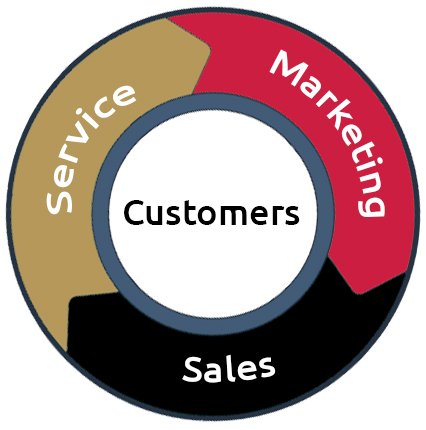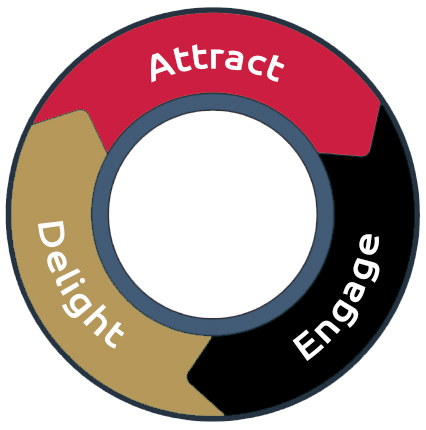Understanding the Fundamentals of Inbound Strategy
What Is Inbound?
Before learning the inbound fundamentals, we must understand what is inbound?
Inbound is a business philosophy based around helping people. It is a human-centered approach by creating one to one relationships with strangers, prospects, and customers.
Inbound is much of a mentality as well as a business strategy. It is the end to end business model that reflects human behavior.
Inbound Business Model
The business model creates a seamless experience for the prospect and customer, when going through marketing, sales, service, and back to marketing.

Inbound Practice
An inbound practice would be to put yourself in the customers shoes and ask these questions:
- How would I want to be marketed to?
- How would I want to be sold to?
- How would I want to get service from a company?
What are the benefits of inbound?
The benefits of using inbound covers all areas of your business, marketing, and sales teams. But what are the overall benefits for the business and consumer?
Benefits for the business:
- Attract prospects that align with your business goals.
- Attract prospects by being helpful.
- Adaptable inbound tools and techniques that evolve towards the buyer’s behaviors.
- Opportunities are found by providing additional insight or information.
Benefits for the consumer:
- Genuine attention about the problems.
- Receiving answers to questions easily.
- Engagement through communication platforms that are valued the most.
- Delivering the right information at the right time.
Benefits for both the business and consumer:
- Leveraging data to create human centered experiences.
- Understanding what motivates your prospects and customers.
- Delivering an experience that prospects value.
- Greater awareness to pain points.
What is the inbound methodology?
Inbound methodology covers 3 stages for the marketing, sales, and services teams to use, to create and maintain relationships with people.

The inbound methodology is a method of attracting, engaging, and delighting people to grow a business that provides value and builds trust.
During the attract stage, an inbound business focuses on attracting prospects and customers through relevant and helpful content. The engage stage begins the moment a person takes the desired action. And the delight stage revolves around providing an outstanding experience every time a prospect or customer interacts with your company.
These are some tools that can be used to attract, engage, and delight prospects:
Attract Tools
- Ads
- Video
- Blogging
- Social Media
- Content Strategy
Engage Tools
- Lead Flows
- Email Marketing
- Lead Management
- Conversational Bots
- Marketing Automation
Delight Tools
- Smart Content
- Email Marketing
- Conversations Inbox
- Attribution Reporting
- Marketing Automation
For lasting relationships it’s important every customer facing team member focuses on how they can contextually attract, engage and delight prospects and customers to build trust in the brand.
What are the fundamentals of an inbound business?
The inbound fundamentals are a set of strategies. Each strategy is purposeful to help your prospects and customers make smart and well-informed decisions towards their investment.
The 5 Inbound Strategies:
- The Inbound Principles
- Your Company’s Purpose
- How Your Business Goals Align
- Your Buyer Personas
- Your Buyer’s Journey
1. The Inbound Principles
The inbound principles are the guidelines for each interaction your teams have with prospects or customers. They shape the way your brand communications.
- Standardize for consistency – Trust is built on consistency of messaging and information. When content is standardized any challenge can be taken with confidence.
- Personalize for impact – Personalize previous messages by contextualizing them to give a personal touch. This also builds trust from the person.
- Optimize for clarity – Delivering the best marketing, sales, and service by fitting the needs for customers and prospects and using the right tools for different situations.
- Empathize for perspective – Having empathy and being adaptable is the inbound way.
When implemented correctly, your business strategy will align with your human centered interactions and helpful services.
2. Your Company’s Purpose
It is not always about how your business communicates. It is also what is the reason behind the words and why your company communicates the way it does. Your purpose is why your company exist and what you are doing for other people that is making a positive difference.
“To inspire your staff to do good work for you, find a way to express the organization’s impact on the lives of customers, clients, students, patients – whomever you’re trying to serve. Make them feel it.”
Harvard Business Review
Why does your company exist?
What impact are you having for other people, that is truly making a difference?
Having a clear purpose allows your marketing, sales, and service teams to genuinely put themselves in the shoes of the prospects and customers and remain connected to the people they are serving.
3. Business Goals
It is more productive when every individual, contributor, executive in your company is working on the same end goals and destination. By working towards the same goals and aligning with the sales, marketing, service team goals will bring greater results and a unified sense of who you are trying to attract, engage and delight with your company.
Poorly defined goals:
- Increase website visitors and leads.
- Generate larger email list.
- Rank number one in Google.
The reason they are poorly defined goals is because they are not specific. By setting SMART goals, you and your team will know exactly what you are working towards.
3. Buyer Personas
The buyer personas are semi-fictional representations of your ideal customer based on real data and some educated speculation about demographics, behaviors, motivations, and goals. Buyer personas are created by research, analysis, and current customers. This helps create the right content when putting yourself in the same mindset of your prospects and customers. The buyer personas are like the glue that keeps everything together, weather they are marketing, sales, or services, they all share the same personas. This allows the entire company to communicate about the same idea customers, the same way.
4. Buyers’ Journey
The buyer’s journey is the process buyers go through to become aware of, consider and evaluate, and decide to purchase a new product or service.
The buyers journey consists of 3 stages:

These stages can be used in different ways for marketers, sales, and services teams. Marketers can use the buyer’s journey to create different content for every stage. Sales can use the buyer’s journey to better understand on how to sell and guide them through the buyer’s journey. And for services, can use the buyer’s journey to understand what your customers journey looks like.
Conclusion
The buyers today are more empowered with the ability to-do their own research online about your product, industry, and competition.
“To be an inbound business, you need to have a system in place to help delight those prospects or customers so that they become promoters and start to influence those strangers.”
Jorie From HubSpot Academy.
Your inbound growth platform should consist of different tools that you can use to align your entire organization. The foundation of a CRM (customer relationship management) tool is needed to develop
To grow in inbound you would need different tools that you can use to align your entire organization. The foundation that you’ll need is a CRM and we recommend HubSpot as the number 1 choice to build your business with.
